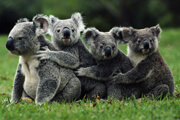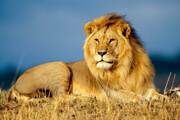Horses have been around for millions of years, so it's about time you stopped horsing around and found out some cool facts about these great animals!
Horses - From the Horse's Mouth
Horses belong to the Equus family, which also includes zebras, mules and donkeys. It's estimated that there are about 750 million horses in the world, and they play different roles depending on where they live. In wealthier countries, horses are used for leisure, like horseback riding, and sport, including horse racing and equestrianism. But in developing countries, they're used for work - since they're strong, they can pull plows, carriages and all sorts of other heavy things.
Horses - Horse Breeds
There are more than 350 different breeds of horses. They fall into four main groups.
- Light - Have small bones and weigh less than 1,300 pounds. These are usually the riding horses. Examples are Thoroughbreds, Morgans and Arabians.
- Draft - Also called "heavy" horses and can weigh up to 2,000 pounds. They have large bones, sturdy legs and are usually working horses. Examples are Percherons, Clydesdales and Shires.
- Ponies - Are only about 57 inches tall, so they're smaller than horses. Examples are Shetlands, Haflingers and Cobs.
- Feral - Wild or semi-wild horses. An example is a Mustang.
Horses - Animal Behavior
Horses have four gaits (ways of moving around) - the walk, the trot, the canter and the gallop. These are natural gaits that all horses know, but there are other gaits that require special training, including the pace, the rack and the fox trot (no, not the dance!).
Horses - More Animal Behavior
Horses are herd animals, so they like living with other animals. They communicate by nickering (making soft, neighing sounds), grooming and using body language. You can usually tell what horses are thinking by their ears!
- Ears that are flat against the neck means the horse is sad or annoyed.
- Ears that are alert and facing forward means the horse is happy.
- Ears that are lowered to the sides means the horse is relaxed, bored or feeling sick.
- Flickering ears means the horse is listening and attentive.
Horses - Did U Know?
- A newborn foal can stand up within the first hour and keep up with the herd within 24 hours. However, it can't eat grass because its legs are too long to reach it!
- Horses usually live to be 25 to 30 years old. The oldest horse ever was Old Billy (an English barge horse) who lived to be 62 years old. Wow!
- The horse is one of the animals in the Chinese zodiac. Those born in the Year of the Horse are considered to be intelligent, independent and free-spirited.
- Although it's taboo in the US, England and Australia, many European and Asian countries eat horse meat, which is sweet, tender, low in fat and high in protein.

































